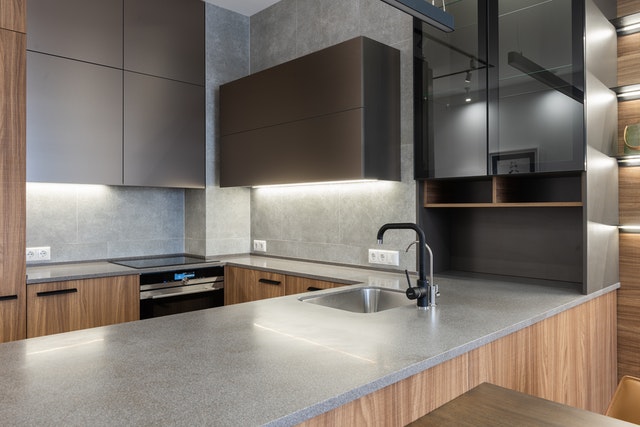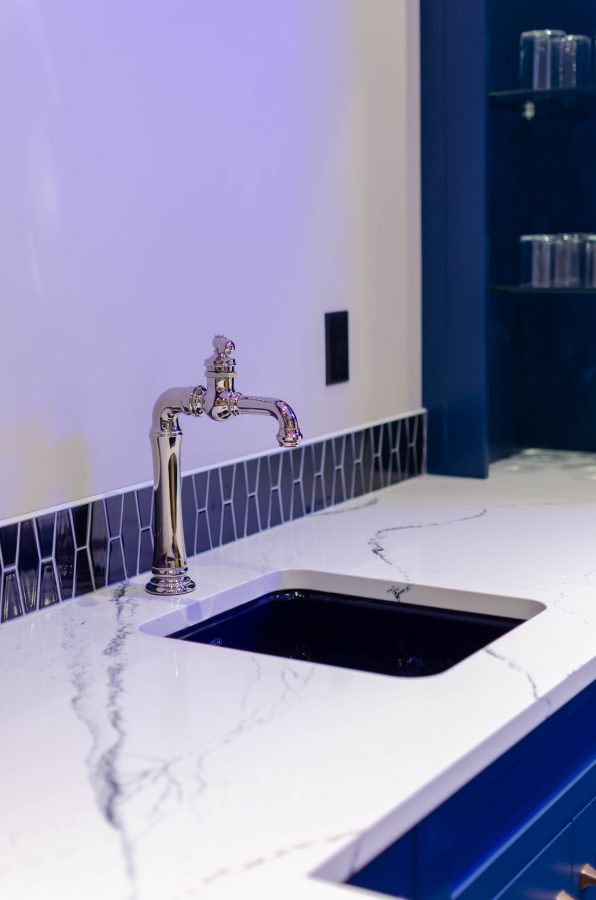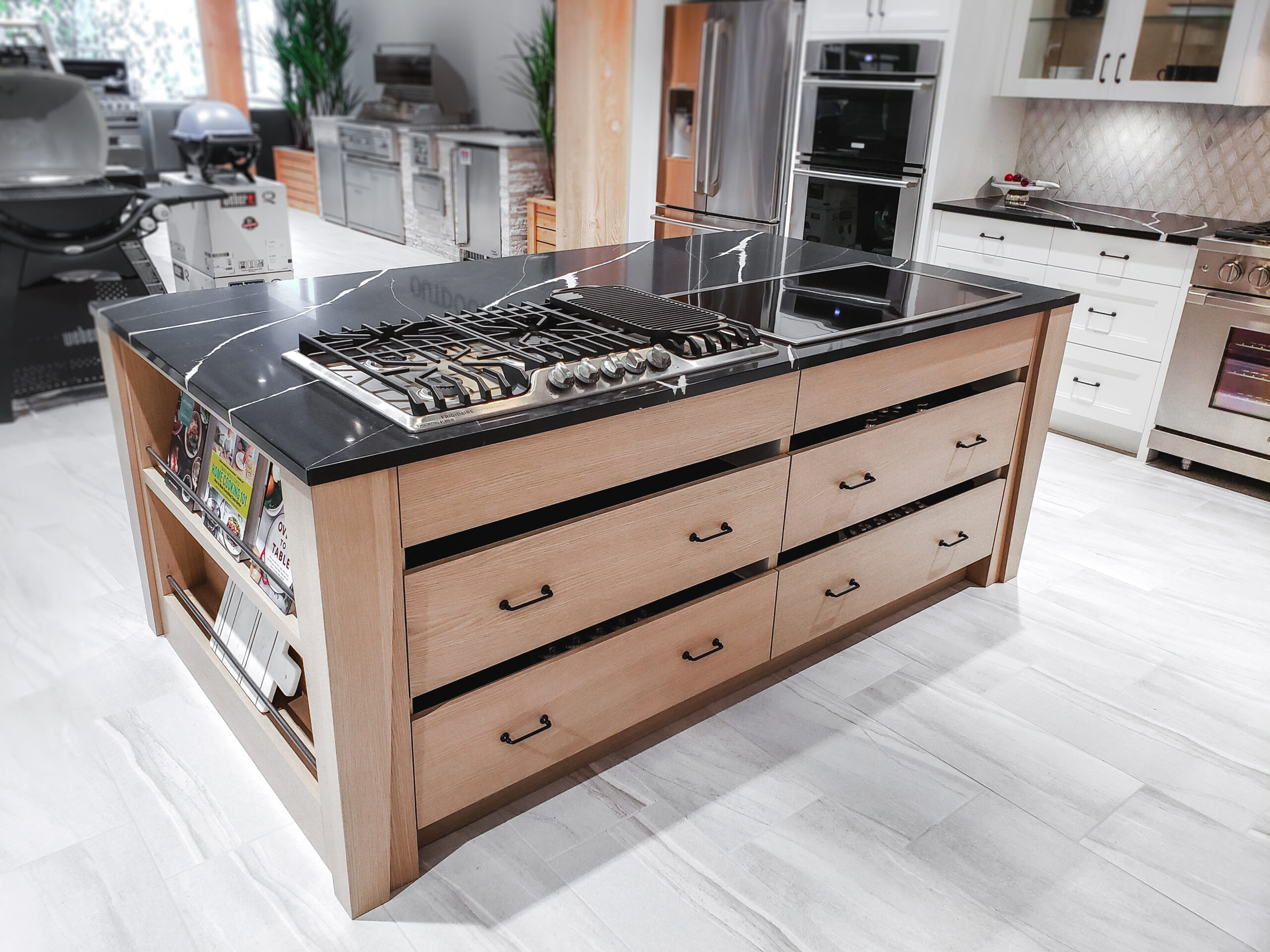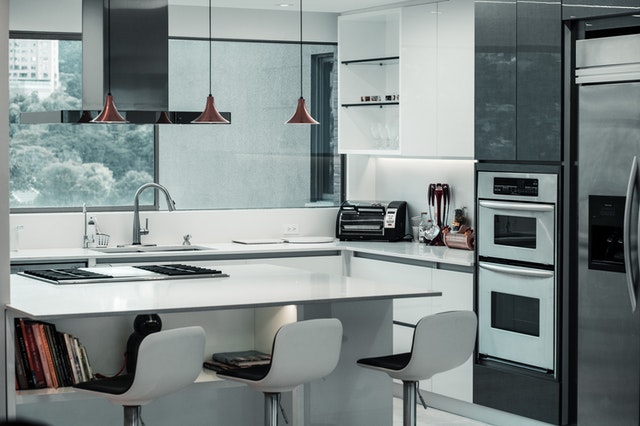Choosing the surface material for your countertops is one of the biggest decisions of your kitchen renovation. Countertops are also some of the most-seen items in your kitchen and central to the overall aesthetic of the room, so there’s no denying the importance and power of selecting the perfect material, colour, and finish.
The choice can be daunting and overwhelming, given the plethora of options available on the market – and all of them offer a different approach, and a different vibe to renovating and enjoying your revamped kitchen. Regardless of where you draw your inspiration from, we’ve selected a few mainstays that will inevitably be on your mind come countertop decision time, as well as a few lesser known alternatives that you may find suit the personality of your design perfectly.
Quartz Counter

A true jack-of-all-trades, quartz – also known as engineered stone, is an ideal compromise between authentic stone countertop materials and the easy maintenance-free allure of solid surfacing. It’s now the most popular countertop material on the market – specifically when crafted to match the visual appeal of marble – because if its versatility, durability, and style.
Constructed using quartz chips and coloured resin, quartz surfacing is a durable and beautiful option for countertops. It can both resist staining and bacterial build up thanks to its nonporous surface, and resists scratches, heat, and chipping thanks to its stone component. Plus, it’s available is a huge array of colours and patterns as its an engineered product.
A quartz countertop’s durability and adaptability make it comparable in price to most authentic stone options at $40-$90 per square foot, but it can lack the natural differentiation on pattern and colour like the real-deal.
Soapstone
A true up-and-comer, soapstone is growing in popularity thanks in part to its warm, homey appeal, and its soft subtlety. Soapstone is naturally soft and almost semi-translucent and darkens naturally over time. Starting as a light grey, the aged patina look of soapstone in a few years time is an added aesthetic bonus for many buyers.
To maintain soapstone, homeowners need to polish the surface to ensure it remains in top shape. It can crack over time and has difficulty standing up to knives and scratching like some more resilient stones, but the natural roughness is a surefire people pleaser. Installed, soapstone can run anywhere from $70-$100 per square foot.
Concrete
An edgy and energetic countertop surface material option, concrete can be poured on-site to deliver some showstopper results and industrial energy that pairs well with many complimenting features and materials in both modern and contemporary kitchen designs. With the right sealer, and a dedication to maintaining a concrete counter, the material is steadily growing in popularity, thanks in part to its ability to be customized with any variation of colour and visual texture.
Often poured on-site, a concrete countertop is just about as custom as you can get, but be forewarned, like all stone materials, concrete requires a sturdy base cabinet to support the weight of such a formidable chunk of countertop. Concrete will also stain without frequent sealing thanks to its porous nature, and will inevitably develop small cracks over time. You’ll be looking at $75-$125 per square foot installed.
Butcher Block
If you’re going for a rustic, authentic, and warm countertop accent – maybe as the island, say – a butcher block wood countertop is the ideal choice that lends itself well to a high-traffic workstation, a functional breakfast/coffee bar, and an up-cycled aesthetic that lends itself to providing contrast and life to the sometimes drab and sterile vibe of some ultra modern kitchen designs.
As a living surface, butcher block counters are prone to changing colour, texture, visual look, and even shape through warping, and use over time – but to some this natural evolution is a strong benefit. Key to choosing the right wood is understanding different hardness, grain aesthetics, and sustainability factors – all while understanding that maintenance and sealing are constant requirements to this vibrant and organic material. Expect to pay anywhere from $30-$85 per square foot – materials only – depending on the wood you choose.
Composite
Born of an Eco-friendly combination of recycled paper and resin, paper composite countertops may sounds flimsy and weak, but don’t judge a book by its cover just yet – they’re tougher than they sound. Paper composites are surprisingly durable and stand up to the effects of heat and water moisture with astounding resilience.
Visually, composite’s have the appeal of solid surfacing or laminate surfaces, but with a warmer and uniquely sustainable feel. They’re considerably lighter than stone or concrete materials, and require the occasional oil or sand to revive the surface layer for general upkeep. Composite’s are susceptible to chemical damage and scratching, and can fetch high-budget numbers at $85-$125 per square foot installed.
Marble Counter Tops
There are few materials that come with the feeling of elegance and grandeur quite like a massive piece of marble countertop.

There are few materials that come with the feeling of elegance and grandeur quite like a massive piece of marble countertop. As the epitome of most traditional choices, marble is adaptive to modern and eclectic kitchen design styles, and this makes it one of the most the preferred choices for the upper echelon of renovators.
As a material, a single piece of marble can differ in terms of colour, texture, and geologic makeup, meaning every square inch will be unique and gloriously authentic. It’s hard, durable, stands up to heat very well, and maintains a constant crown of baking station and/or island countertop materials.
Its potential downside is a distinct susceptibility to staining, even after sealing – this means that the majority of homeowners who do their research will choose to keep their marble selection to a moderately smaller area, rather than outfit the entire space in marble. It’s also prone to the odd crack or chip. Typically, marble is expensive – costing $40-$100 per square feet installed.
Laminate
A mainstay of kitchens for the past 80 years or so, laminate countertops are constructed of a blend of paper, resin, and particle board fused together. The word ‘laminate’ has traditionally been met with immediate feelings of cheapness and of questionable style – but that’s changing in a big way. Modern laminate countertop designs are being made to mimic the natural look of stone, concrete, butcher block, and more – meaning that for $10-$30 per square foot, you can have the look of some of the most expensive materials available in a budget build, or as a last minute add-on.
It’s very low maintenance and easy to clean – and its lightweight means it doesn’t require the Atlas-like support of a beefed-up cabinet base. It is prone to scratch over time, burns, and in rare cases, stains. It’s tough to repair if it is damaged, and the gist of its construction means it can’t be used if you’ve got your heart set on an under-mount sink.
Countertops Granite
The beautiful, varied features, colours, and patterns of granite stone make it one of the most sought after countertop materials on the market because each piece is truly one-of-a-kind. The natural look and often times rugged appeal of a granite counter can beautifully intertwine with a refined and sophisticated kitchen design in an ultra-desirable way.
Granite is tough, resilient to knife nicks, heat, chemical cleaners, and other general wear and tear, but it must be sealed every so often to avoid staining like most stone countertop alternatives.

As well, the sheer weight of granite mean the choice also requires corresponding respect be given to sturdy cabinet support bases to satisfy the weight of the stone. Installed, granite countertops can run $35-$100 per square foot.
Solid Surfacing Counters
A unique blend of polyester and acrylic, solid surfacing was once sold under the brand name, Corian, though today that term is well-used as a generic title as it’s manufactured by a slew of reputable organizations and is enjoying steadily growing popularity thanks to its maintenance-free nature.
Solid surfacing is entirely independent of the need to seal like stone products because it’s nonporous, and while it can be susceptible to scratches or burns, they are easily and effortlessly sanded out. Colours and pattern options are vast is solid surfacing countertops, and installation is all seamless so there’s never any worry to clean cracks of debris and grime.
Solid surfacing does not stand up to heat very well, and can scratch easily over time. It also has a slightly artificial look that can reduce its allure in some kitchens, and boost its appeal in others. As a versatile and customized option, solid surfacing can fetch anywhere from $35-$100 per square foot.

Kitchen designers can help you weigh the pros and cons of each option further, and can be a huge help in describing their personal experiences dealing with each, offering an invaluable resource that’s geared at helping you make the decision that’s right for you.
What makes countertop choices so important to homeowners is the vast array of choices available in today’s market. Your countertop is going to take a lot of abuse, use, and be the site of many conversations, get-togethers, and after-dinner drinks, so choosing one that embodies your lifestyle, your values, and your own personal style are the key pillars of this exciting deliberation.
Whatever your decision, always go with your gut and select the one that feels right for you and your renovation.